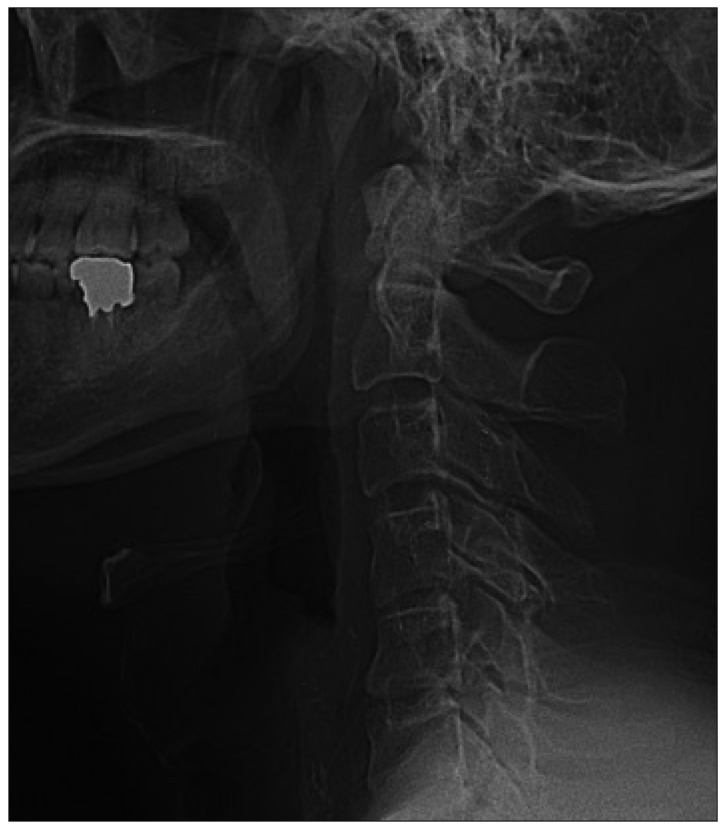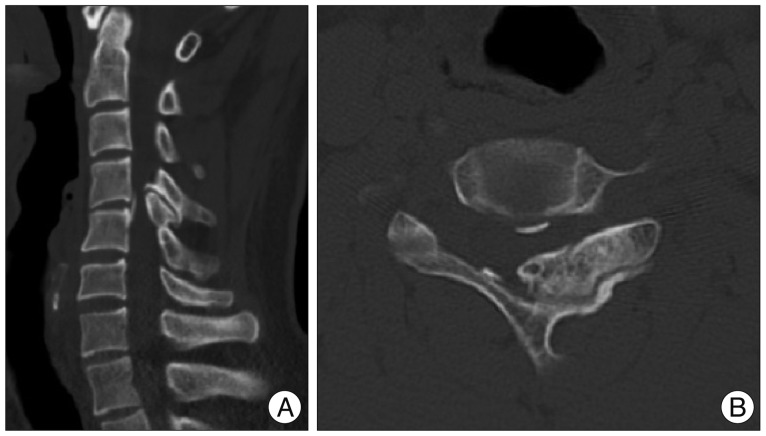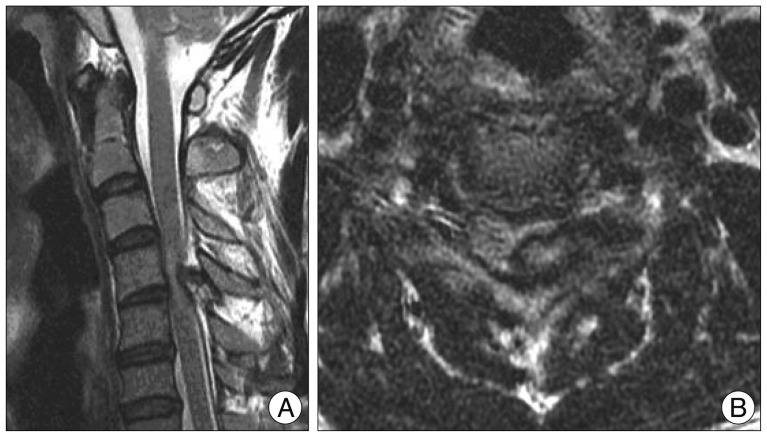J Korean Neurosurg Soc.
2012 Apr;51(4):233-236. 10.3340/jkns.2012.51.4.233.
Subclinical Cervical Osteochondroma Presenting as Brown-Sequard Syndrome after Trivial Neck Trauma
- Affiliations
-
- 1Department of Neurosurgery, Soonchunhyang University College of Medicine, Bucheon Hospital, Bucheon, Korea. isbrzw@schmc.ac.kr
- KMID: 2066918
- DOI: http://doi.org/10.3340/jkns.2012.51.4.233
Abstract
- Osteochondroma is a rare condition in the spine that may be indolent due to its slow growth. The authors present a case of 32-year-old man with subclinical osteochondroma in the cervical spine presenting as Brown-Sequard syndrome after trivial neck trauma. After resection of the tumor through hemilaminectomy, his symptoms were improved with mild residual sequelae.
Figure
Reference
-
1. Akagi S, Hashiguchi J, Sasai K, Kato I, Saito T, Ogawa R. Osteochondroma of the upper cervical spine presenting as vertigo. Orthopedics. 2003; 26:187–188. PMID: 12597225.
Article2. Chatzidakis E, Lypiridis S, Kazdaglis G, Chatzikonstadinou K, Papatheodorou G. A rare case of solitary osteochondroma of the dens of the C2 vertebra. Acta Neurochir (Wien). 2007; 149:637–638. PMID: 17450439.
Article3. Cheng WY, Shen CC, Wen MC. Ganglion cyst of the cervical spine presenting with Brown-Sequard syndrome. J Clin Neurosci. 2006; 13:1041–1045. PMID: 17113987.
Article4. Cirak B, Karabulut N, Palaoglu S. Cervical osteochondroma as a cause of spinal cord compression in a patient with hereditary multiple exostoses : computed tomography and magnetic resonance imaging findings. Australas Radiol. 2002; 46:309–311. PMID: 12196244.
Article5. Grivas TB, Polyzois VD, Xarchas K, Liapi G, Korres D. Seventh cervical vertebral body solitary osteochondroma. Report of a case and review of the literature. Eur Spine J. 2005; 14:795–798. PMID: 15912348.
Article6. Han IH, Kuh SU. Cervical osteochondroma presenting as brown-sequard syndrome in a child with hereditary multiple exostosis. J Korean Neurosurg Soc. 2009; 45:309–311. PMID: 19516952.
Article7. Kim WJ, Kim KJ, Lee SK, Choy WS. Solitary pelvic osteochondroma causing L5 nerve root compression. Orthopedics. 2009; 32:922. PMID: 19968229.
Article8. Kim YS, Lee JK, Joo SP, Kim SH. Brown sequard syndrome resulting from cervical disc herniation treated by anterior foraminotomy. J Korean Neurosurg Soc. 2005; 38:136–140.9. Maheshwari AV, Jain AK, Dhammi IK. Osteochondroma of C7 vertebra presenting as compressive myelopathy in a patient with nonhereditary (nonfamilial/sporadic) multiple exostoses. Arch Orthop Trauma Surg. 2006; 126:654–659. PMID: 16906423.
Article10. Roach JW. Hereditary multiple exostoses with spine involvement in a 4-year-old boy. Am J Med Genet A. 2010; 152A:1263. PMID: 20425832.
Article11. Sakai D, Mochida J, Toh E, Nomura T. Spinal osteochondromas in middle-aged to elderly patients. Spine (Phila Pa 1976). 2002; 27:E503–E506. PMID: 12461407.
Article12. Schomacher M, Suess O, Kombos T. Osteochondromas of the cervical spine in atypical location. Acta Neurochir (Wien). 2009; 151:629–633. discussion 633. PMID: 19290470.
Article13. Xu J, Xu CR, Wu H, Pan HL, Tian J. Osteochondroma in the lumbar intraspinal canal causing nerve root compression. Orthopedics. 2009; 32:133. PMID: 19301786.
Article14. Yagi M, Ninomiya K, Kihara M, Horiuchi Y. Symptomatic osteochondroma of the spine in elderly patients. Report of 3 cases. J Neurosurg Spine. 2009; 11:64–70. PMID: 19569943.
- Full Text Links
- Actions
-
Cited
- CITED
-
- Close
- Share
- Similar articles
-
- Cervical Osteochondroma Presenting as Brown-Sequard Syndrome in a Child with Hereditary Multiple Exostosis
- Brown-Sequard Syndrome due to Herniated Cervical Disc
- A Brown-Sequard Syndrome Resulting from a Ruptured Cervical Disc Herniation: A Case Report
- Brown Sequard Syndrome Resulting from Cervical Disc Herniation Treated by Anterior Foraminotomy
- Motion Preserving Surgery in Two Cases of Brown-Sequard Syndrome Caused by Herniated Cervical Discs







